Odds are, you’ve heard the phrase “there’s always room for improvement” once or twice before.
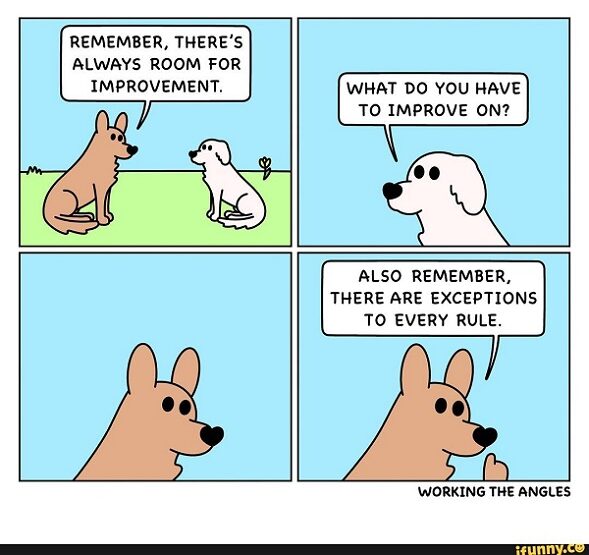
Although you might feel like your SEO could be an exception to this saying, there’s almost always some way you can optimize your SEO strategy to get a higher return on investment. (Yes, even if you’re already getting decent results.)
But where to start? We’re outlining the 14 most common SEO mistakes we see businesses make and how you can fix them.
SEO mistakes your business should avoid
Make sure your SEO strategy is optimized to its full potential by avoiding these common SEO mistakes:
Mistake #1: Choosing the wrong keywords
Search volume (SV) and keyword difficulty (KD) are metrics you’ll find in most SEO tools. Respectively, they refer to how many searches a term gets monthly and how hard it will be to rank for.
Why keyword choice is important
It may seem logical to choose keywords with a high search volume since SEO is meant to drive website traffic. However, they’re often too competitive for newer or low domain authority websites to rank for.
Knowing this, many people default to SEO keywords with low keyword difficulty instead. Yet, lots of these keywords may be too low volume to generate the results you need in a timely manner. Plus, SEO tools don’t calculate KD based on the strength of your website specifically. As a result, they aren’t always an accurate representation of your ranking potential.
The fix: How to choose the right keywords
Of course, any keywords you choose should relate to what your business does. Beyond that, what if your domain isn’t strong enough to compete with the top authority sites in your industry? Opt for low to medium-difficulty keywords that also have decent search volume. To help get you started, try an online keyword tool, like the WordStream Free Keyword Tool.
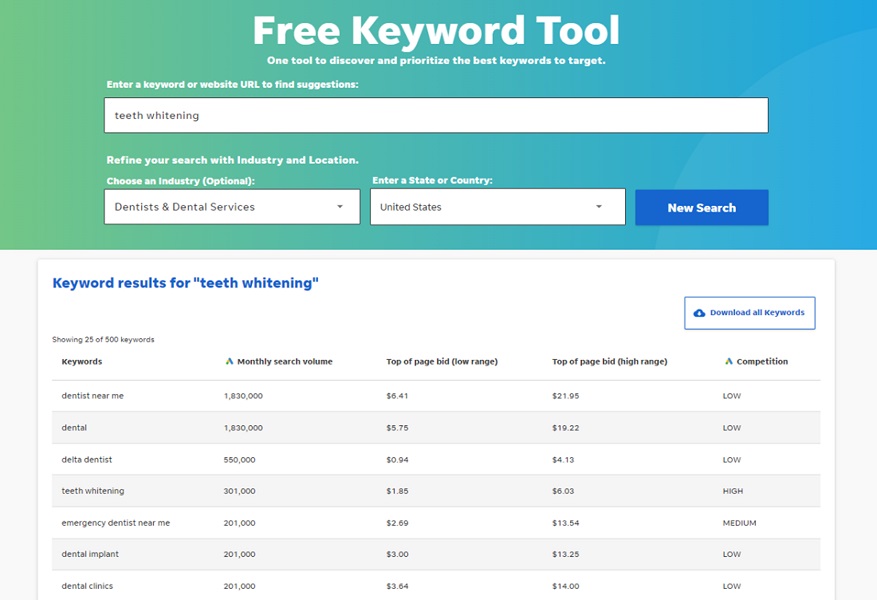
Mistake #2: Failing to satisfy search intent
Search intent is what a person wants from search results when typing a query into a search engine. You can understand their intent by analyzing the keywords they use. They fall into four categories:
- Informational intent. Searchers want to be educated on a topic.
- Commercial intent. Searchers are researching their options in preparation for making a purchase.
- Transactional intent. Searchers have decided on a solution and are ready to buy.
- Navigational intent. Searchers want to visit either a physical location or a specific location on the web.
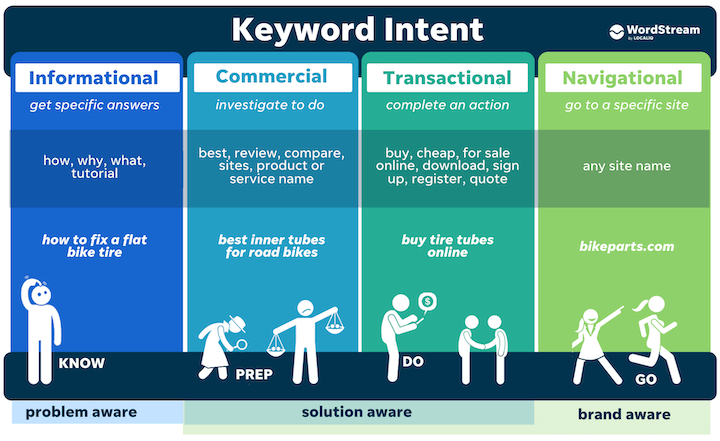
Why search intent is important
Know how search engines decide what pages to rank on and near the top of page one in search results? In part, by evaluating which pages give searchers what they’re looking for (i.e. the best answers to their queries). For your SEO content to stand any chance at ranking, it has to satisfy intent better than competing content.
The fix: How to satisfy search intent
There are three steps to matching intent and doing so better than pages you hope to outrank in search:
- Understand your audience’s intent as it relates to a specific target keyword.
- Determine what your content should and shouldn’t include.
- Look for ways to improve upon existing content (e.g. clearer explanations, more thorough topic coverage, etc.).
For example, the query “buy a franchise” has commercial intent. What should content created for that target keyword cover? Topics like the best franchise opportunities, anticipated purchase costs, and the buying process.
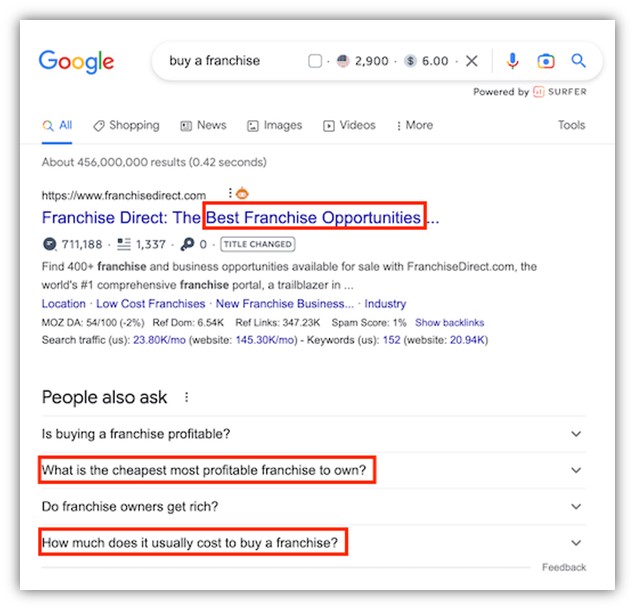
Look at how others write for your target query and see what you can do better. Have they missed a relevant topic that you could cover? Could you into greater detail or present the information in a more clear and appealing way?
Mistake #3: Focusing on keywords and not topics
Keywords do play a part in getting content to rank in relevant search results. Choosing the right ones is crucial. But there’s more to optimizing a piece of SEO content than making sure your target keyword is included.
Why topic coverage is important
In the old days of SEO writing, search engines relied on exact keyword mentions to understand what a page was about and rank it accordingly. But they’re smarter now. They know the pages with target keywords in all the right places aren’t necessarily the best. Hence the reason they now favor pages that cover all the subtopics most closely related to a search term.
The fix: How to cover topics thoroughly
Do you consider yourself an expert in your field? If so, you’ll likely have a pretty good feel for what subtopics relate to your target keywords. However, SEO tools—specifically content optimization tools—can be handy. Just to double-check that you haven’t left out any crucial information or ventured off into less relevant subtopics.
At the very least, you can use a free tool like Keyword Surfer. The Overlap feature shows how similar search results are for each keyword compared to your main query. As a rule of thumb, you’ll want to cover most of the ideas with the highest overlap and avoid the ones with the lowest.
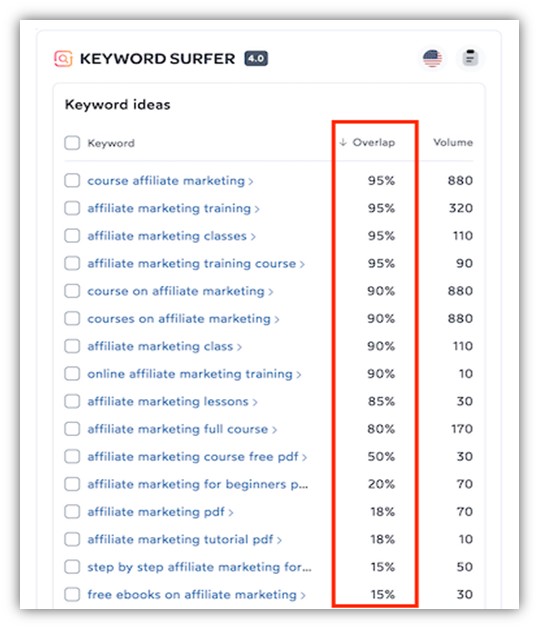
You can also use a more sophisticated tool like my personal favorite—Clearscope. It allows you to visualize subtopics competitors cover, gives recommendations to help you rank, and shows how well you’ve implemented those recommendations.
Mistake #4: Not writing to win featured snippets
Featured snippets are information boxes that appear at the top of search results. They answer searcher queries immediately via paragraphs, bulleted lists, or other formats.
Why winning featured snippets is important
Pages that rank lower in search results, get fewer clicks than those that rank closer to the top of page one. The great thing about featured snippets is they appear at the very top above organic results. Winning them can increase the visibility of your SEO content, at the very least. And it can also drive traffic to your website.

An example of a featured snippet.
The fix: How to win featured snippets
Type your focus keyword into Google and see if there’s a snippet in the search results. If so, take note of what type it is (e.g. a paragraph or list). Structure your response to the query in the same format. Plus, if possible, provide a better, more direct, or more comprehensive response.
Mistake #5: Creating unhelpful content
Google’s 2022 Helpful Content Update forced many people to honestly assess the quality of the content they produce. But, in reality, content quality should have been a concern long before then.
Why (truly) helpful content is important
Search engines have a monumental task: deciding which pages—usually out of several thousand—deserve to rank at the top of search results. To that end, they try to weed out the following:
- Outdated content.
- Content not created by credible authorities and/or published on authoritative, relevant websites, especially for Your Money Your Life (YMYL) topics.
- Pages that are over-optimized using tactics like keyword stuffing.
- Underoptimized pages that use very few relevant search terms and only partially cover the subject matter.
- Content that otherwise offers a poor user experience.
Encompassed in that last point is an error that people often forget about—lack of originality.
You could be an expert publishing well-optimized content to an industry-focused site consistently. But what if your content only remixes existing content from competitors? Search engines like Google would have no reason to rank yours over theirs. Especially if theirs contains original research, firsthand experiences, insights from subject matter experts, and so on.
The fix: How to create helpful content
True, you may need to cover topics already discussed in competing content, especially when writing content for SEO. But your goal should be to make your content more valuable than what’s already out there (not just longer).
You can do that in several ways. Share your hard-earned knowledge and collaborate with subject matter experts. Do original research and share your findings. Create complementary visuals to support your written content.
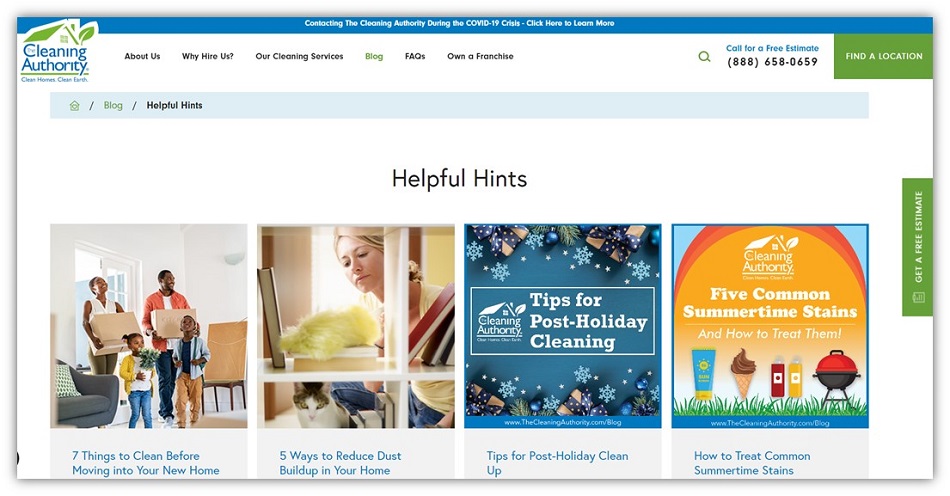
An example of a blog with high-quality, helpful content.
Mistake #6: Not building links (internal and external)
Links—both internal and external—serve at least two purposes. One, they facilitate navigation, and, two, they build credibility.
Why building links is important
Internal links to other pages on your website direct users to related content they’d find interesting or useful. They help visitors navigate your site and, if you choose them wisely, can show that you’re an industry expert.
Internal links also help site crawlers find, understand, and index the pages on your website. This can increase their chances of ranking in relevant search results. This is, in part, because they pass authority to other pages on your site.

Examples of internal links to relevant pages on the Purina site.
Say you have a high-quality piece of content on your site with many many internal pages linking back to it. Site crawlers are more likely to infer that the page is important and may be worth ranking on page one of search results.
External links or backlinks, on the other hand, are like votes of confidence from other websites. Links from reputable sites relevant to your industry tell search engines that a page on your site is top-quality.
The fix: How to build internal and external links
With very few exceptions, every page only our site should link to at least one other. (If you can’t think of a relevant page to link to, you should question whether the page is necessary at all.) Prioritize linking to pages that are not only related by topic but that perform well. For example, if one of your blog posts ranks on page one for multiple keywords and brings in traffic and conversions consistently, link to it often.
As for earning external links, contact non-competitive publishers whose audiences overlap with yours. If they have relevant content and see value in directing their readers to yours, you could create partnerships. But there’s more you can do besides or in addition to outreach. this includes writing guest posts on relevant websites. (Often, you can either include links within the post or ask to add backlinks to other content on the site.)
Pro tip: Periodically find and fix any broken links on your website. This will ensure a seamless user experience for site visitors and help with the transfer of authority from page to page.
Mistake #7: Not having an XML sitemap
Now, onto a more technical mistake. Got an XML sitemap—the file that contains all the URLs within your website? If not, here’s why building one should be on your to-do list.
Why an XML sitemap is important
Sitemaps make discovering and indexing important pages on your site easier and faster for search engine crawlers, even in the absence of internal links. They also give extra info about the pages, such as update frequency and content priority. These details help search engines understand the website’s structure and identify the most important pages.
To give you an idea of what they look like, here’s a basic sitemap that specifies the location of just one URL.
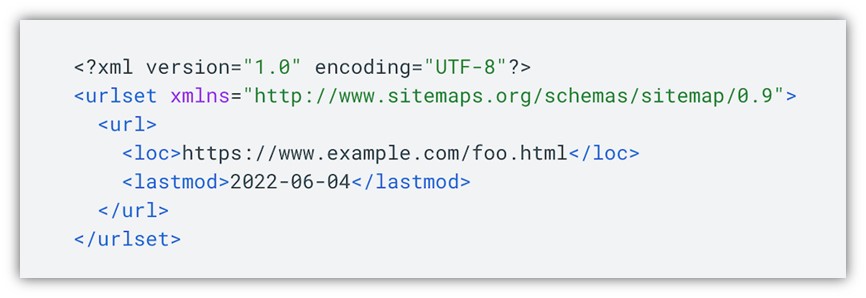
Additionally, XML sitemaps can help you spot problems with indexing. Problems that would prevent your web pages from appearing in search results.
The fix: How to create an XML sitemap
Many content management systems will generate sitemaps for you. Do a quick Google search to see if yours is one of them. If not, try a plugin such as Yoast, which walks you through the setup process. As a last resort, you can also create your sitemap manually. But this is a more technical and time-consuming project.
Note: Going the manual route? Don’t forget to submit your sitemap to Google once it’s done. You can do this on the Google Search Console Sitemaps page.

Mistake #8: Neglecting site speed and performance
Pop your website into Google PageSpeed Insights. How does it score in terms of performance?
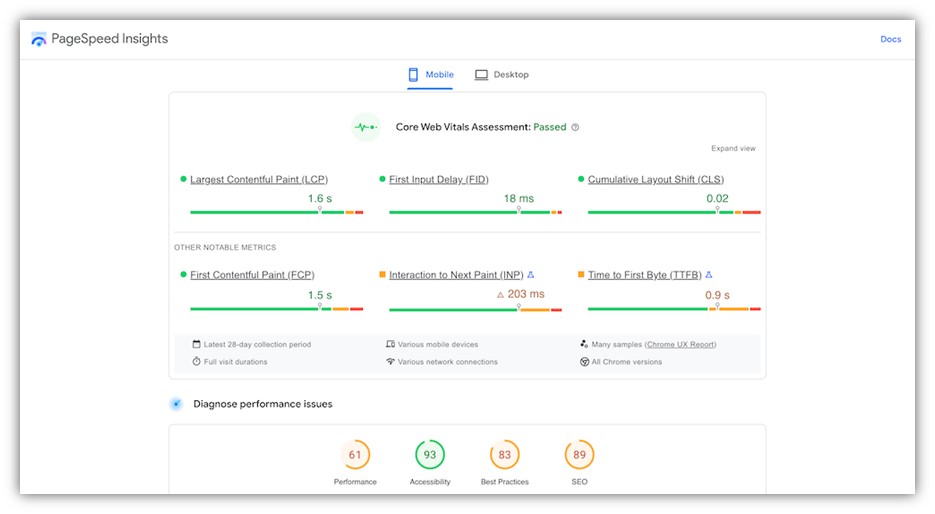
If your score isn’t in the green, your web pages load slower than recommended. Your SEO is likely suffering as a result.
Why website speed is important
As mentioned, search engines try to rank the pages that offer the best user experience—fast loading included. That’s why page speed can impact if and where your pages show up in search engine results pages (SERPs).
The fix: How to improve site speed
PageSpeed Insights offers specific recommendations for improving website performance. They often include tasks like reducing unused Javascript and CSS. But you can also do things like reducing image size and getting rid of unused plugins. Or using a caching plugin to serve stored versions of your web pages quickly and choosing an efficient website theme.
Mistake #9: Not having a mobile-first site
The content and user experience on the desktop version of your site could be flawless. However, if it’s not just as good on mobile, your SEO will suffer.
Why a mobile-first site is important
More people use Google on mobile than on desktop. So, it makes sense that Google has shifted to indexing and ranking the mobile versions of sites. If your site isn’t mobile-friendly, let alone mobile-first, it will be harder to rank well in relevant search results.
The fix: How to create a mobile-first site
Given that switching to a mobile-first approach will be one of 2023’s biggest SEO trends, you need a game plan for your own site. Invest in responsive web design, which can automatically adjust how content is displayed on different devices. Also, follow Google’s recommendations such as ensuring that page content and metatags are the same on both the desktop and mobile versions of your website.
Mistake #10: Not using schema markup
Schema markup is a type of microdata. It gives search engines extra context about the content on a website.
Why schema markup is important
Schema markup helps search engines present content in a more accurate and helpful manner in search results. For example, you’ve probably seen “rich snippets,” or enhanced descriptions of web pages in search results. Think reviews, ratings, or pricing information like you see below. Their purpose is to help websites stand out and drive more traffic.

In addition to improving the appearance of search results, schema markup can also help search engines to better understand the relationships and meanings behind different entities on a website. For example, it can help search engines understand that a certain product mentioned on a webpage is related to a specific brand or category.
The fix: How to implement schema markup
If you’re familiar with HTML, you can mark up your pages manually using the instructions from Schema.org. (Be sure to check your work afterward with Google’s Schema Markup Validator.) But, especially for large sites, this is a slow and tedious process.
There’s an easier and more user-friendly way. Use a tool that allows you to select from different schema types and handles the HTML for you. My favorite (for WordPress sites) is RankMath.
Mistake #11: Duplicate content
Duplicate content is just what it sounds like. Identical or near-identical content that appears on the web in more than one place (either on the same website or different sites).
Why removing duplicate content is important
Having duplicate content on your website, especially in high quantities, can leave search engine crawlers confused about which pages to rank. The result? Lower rankings and decreased visibility overall. Plus, if your content has been outright copied from other sites or is highly similar, it will struggle to rank due to the lack of originality.
The fix: How to avoid content duplication
As far as preventative measures go, the most obvious rule is to avoid copying content from other sites. But it’s also important to avoid duplicating content from your own site. Keep track of the content you publish. Also, do at least a semi-annual content audit to spot identical content or pieces that overlap too much.
To fix existing duplicate content issues on your site, there are three things you can do:
- Remove duplicate pieces
- Use 301 redirects to point visitors and search engine crawlers to the original page on the site
- Use canonical tags to let search engines know which version of the content is the main one and, as a result, what page to index and rank
While it’s a myth that there’s a formal duplicate content penalty, you still don’t want this content on your site. Removing it will prevent damage to your credibility and improve user experience.
Mistake #12: Bad (or no) Google reviews
Trying to drive customers to your physical business location? If so, your reviews on Google (or lack thereof) can play a big part in how easy it is to find your business online.
Why having positive Google reviews is important
Google wants to direct searchers to the most reputable sources; its own reputation depends on its ability to do that. So, logically, the Google 3-Pack doesn’t show any three relevant businesses. It typically shows three of the top-rated businesses related to your query.
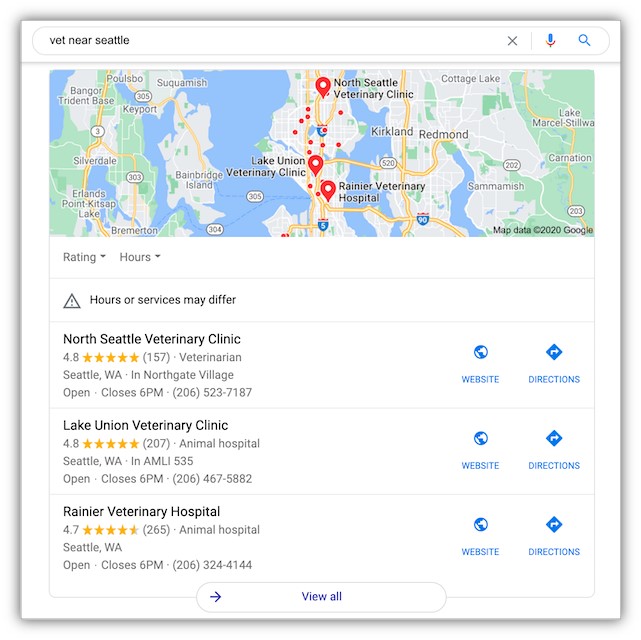
Good ratings and reviews, especially when you receive them often, signals to Google that your business is worth showing to searchers.
The fix: How to get more positive Google reviews
The way to get great reviews is not to pay someone to fake them or to bribe customers into leaving you five stars. Google and searchers can often spot reviews that don’t seem genuine and that wouldn’t do your SEO any good. Plus, manipulating reviews is ethically yucky, anyway.
Instead, encourage your customers to share their honest experiences with your business. If you hear from a happy customer, ask them to write a review. If you send post-purchase follow-up emails, link to your Google Business Profile and ask for a review. Build requests for feedback into your processes. If you offer a great experience to your customers on the regular, you’ll see good reviews coming in.
Mistake #13: Not doing local SEO
Do you only service clients or customers within your immediate area? If so, your website doesn’t need to attract people across the country. They’re not your target market, so you need to focus on attracting the people that are.
Why local SEO is important
Targeting locale-specific keywords often makes the difference between:
- Competing with only a few dozen other businesses, including some with weaker domains or worse SEO than you.
- Competing with hundreds or even thousands of other businesses, including many with stronger domains and better SEO than you.
Similarly, building local citations can be the difference between searchers finding and engaging with your business or going to competitors instead.
The fix: How to do local SEO
Target location-specific keywords (e.g. “pool cleaning services houston”) rather than general keywords (e.g. “pool cleaning services”). This is especially important for content or copy that’s further down the marketing funnel such as services pages.
Local SEO also involves building local citations. You can do this by completing your profiles on sites like Google Business Profile and Yelp, as well as industry or location-specific online directories. Just be sure to use the same information—especially name, business address, and phone number—across profiles.
You can also save this handy local SEO checklist below to improve your overall local SEO strategy:

Mistake #14: Not using Google Search Console
Like Google Analytics, Google Search Console (GSC) is helpful for understanding how your website and content perform. But it’s not only for analyzing performance.
Why using Google Search Console is important
Google Search Console can be a great planning tool to help you:
- Drive more organic traffic
- Increase your click-through rate (CTR)
- Spot content creation opportunities
- Identify content optimization opportunities
It can help you strengthen your SEO strategy overall.

The fix: How to use Google Search Console
There are several ways you can use Google Search Console to improve your SEO. For example, you can request indexing for new content. This ensures that Google is aware of its existence and increases its chances of appearing in search results.
You may also be able to find some content creation opportunities using the Queries tab. See a query that’s getting a lot of impressions but that you haven’t created a piece of content for yet? Publish a page optimized for that term and you could capture more of that existing interest from searchers.
Similarly, you can use the Pages tab to identify content optimization opportunities. For example, what if you notice blog posts that are getting a lot of impressions but few clicks? Experiment with updating their title tags and meta descriptions to improve CTR. Further, if those same pages are underperforming based on the SEO metrics you track in your analytics tool, you could refresh the content on those pages.
Steer clear of common SEO mistakes
Search engine optimization—when done right—can improve your visibility in search results. It can attract site visitors and, more importantly, future customers for a lower cost than paid ads, for example. But, it has to be done right to be successful, which means avoiding SEO mistakes–or correcting them when you find them.
Here are the most common SEO mistakes to avoid:
- Choosing the wrong keywords
- Failing to satisfy search intent
- Focusing on keywords and not topics
- Not writing to win featured snippets
- Creating unhelpful content
- Not building links (internal and external)
- Not having an XML sitemap
- Neglecting site speed and performance
- Not having a mobile-first site
- Not using schema markup
- Duplicate content
- Bad (or no) Google reviews
- Not doing local SEO
- Not using Google Search Console
If you have room for improvement in any of these areas, don’t wait around. The sooner you make adjustments, the sooner you can see an improved marketing ROI from your SEO efforts!






